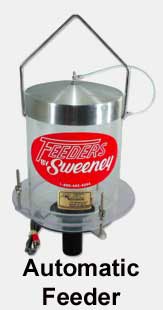Photo Courtesy of Aquatic Ecosystems, Inc.

Like any confined animal, cultured fish only have access to the food provided. The ration needs to be complete, that is, have all the nutrients the fish needs for its entire life cycle ("egg to egg") or malnutrition will occur. Signs of malnutrition include slow growth, disease-like conditions such as twisted skeletons, blindness, or even death. Creating a complete diet for any animal is not easy because some nutrients may be needed in very small amounts at only one stage of the life cycle. In production agriculture, a diet must not only be complete, but be economical as well. The key to economical, complete diets is knowledge of a species' exact requirements for each nutrient. This must be determined experimentally. The critical nutrients include: protein (minimum crude protein as a percentage of the diet and the distribution of this among the ten essential amino acids), fat (amount of required specific lipids and maximum percentage of saturated fat), carbohydrate (for carnivorous fish, maximum tolerated), and vitamins/minerals (amount of daily requirement). Once this is known for a species, a least cost ration formulation can be employed. This involves matching the requirements of the fish with the analysis of various feedstuffs and determining which six or eight major components, and at what percentages, will meet the requirements at the least cost. The feed components are such things as herring meal and soybean meal.
Once the major components are determined, minor ingredients such as vitamin and mineral premixes and binders are added and then the feed is made into kibbles. Pellets can be cold pressed from a damp mixture of ingredients in a machine that is like a meat grinder or they can be steam extruded. If heat is used, the pellets puff up slightly and float when dry. The cold pressed pellets sink. Rations are made in a variety of sizes from a fine powder ("fry mash") to a quarter of an inch (60 mm) in diameter.
The amount that fish are fed depends on the size of the fish and the water temperature. Smaller fish and warmer temperatures mean more food is needed for a given weight of fish. Charts are available (they are often attached to feed bags) that express the amount to feed in terms of percent of the total body weight of the fish to be fed every day for a given temperature and fish size. The charts are species specific. The amount of food fed can vary from less than 1% to about 10% of body weight a day. As a rule of thumb, most recirculation systems require between 2% and 3% during grow out, more for fry and fingerlings. Since the amount to feed is based on the total weight of fish in the tank and the fish are continually growing, the amount fed must be periodically increased. The video describes how this is done.
 |
 |
Carnivorous fish like trout and hybrid striped bass have large stomachs and are adapted to eating large meals and grow out fish can do pretty well on one feeding a day, though feed conversion efficiency (see below) increases with two feedings. More herbivorous fish such as tilapia have small stomachs and are "grazers". They need more frequent feedings, at least two, three, or four times a day are better. Small fish of all species need to be fed more often than larger fish. Fry that have just absorbed their yolk sac ("swim ups" or "button ups") need to be fed every couple of hours. Automated feeders help reduce the labor of frequent feedings. Automated feeders work in several ways to dispense feed. There are scatter, screw, vibration, and belt feeders. All have timers that can be set on a daily schedule. Scatter feeders are intended for ponds and are not appropriate for recirculation units. Screw feeders can handle the greatest amount of feed, while vibration feeders are best for lessor amounts of daily feeding. Belt feeders are best suited for fry feeding where small amounts are fed almost continually. There are also demand feeders which allow fish to feed themselves. These are not recommended for recirculation aquaculture because they lead to overfeeding which can adversely impact water quality.
 |
Livestock producers speak of feed conversion, which is the ratio of weight of feed fed to body weight gain with the feed weight expressed as dry weight and the weight gained as live weight. Obviously, a lower feed conversion ratio is good, since it means less food (and less money) is needed to raise a pound of fish. The best feed conversions of traditional livestock are for chickens which can achieve 2:1. Those for fish can equal or even better that, but may also range much higher if management is less than optimum. Overfeeding reduces feed conversion efficiency (increases the ratio), because food is not assimilated as well. Poor water quality and crowding can reduce the efficiency of turning food to flesh, too.
Ammonia production and oxygen consumption are directly related to feeding. After fish are fed, oxygen consumption begins to increase almost immediately as the fish begin to catabolize their food and continues to rise for an hour or so. Ammonia production begins about the time oxygen consumption peaks and continues for several hours as deamination occurs in the fish's liver. Since acceptable water quality in recirculation units is maintained by constant aeration and nitrification, an increase in oxygen demand or ammonia production will result in decreased oxygen and increased ammonia in the water. If the water quality goes out of the acceptable range, stress and even fish kills can occur. It is important to watch water quality closely after increasing the feeding rate. More frequent feedings of lesser amounts spread the effects on water quality over a longer time, decreasing their severity.